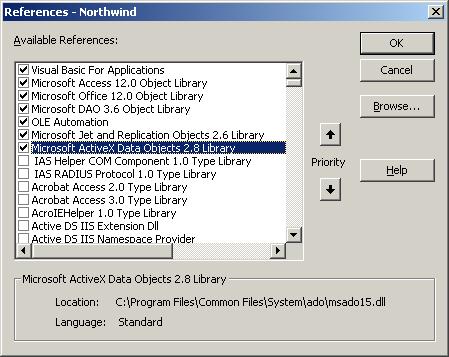Microsoft Activex Data Objects Library For Mac
-->
Microsoft Data Access Components (MDAC) 2.8 SP1 contains core Data Access components such as the Microsoft SQL Server™ OLE DB provider and ODBC driver. This redistributable installer for the MDAC 2.8 SP1 release installs the same Data Access components as Microsoft Windows XP SP2. @PKatona Microsoft ActiveX Data Objects 2.x Library is not a.NET assembly, it is a COM library. It has a corresponding Primary Interop Assembly, ADODB.dll, which.NET can interpret, and hides the integration between CLR and COM. For this reason, AXDO is (and has always been) under COM when adding a reference in.NET.

Microsoft Activex Data Objects Library For Mac Free
ADO gives developers a powerful, logical object model for programmatically accessing, editing, and updating data from a wide variety of data sources through OLE DB system interfaces. The most common usage of ADO is to query a table or tables in a relational database, retrieve and display the results in an application, and perhaps let users make and save changes to the data. Other tasks include the following:
Microsoft Activex Data Object Library
Querying a database using SQL and displaying the results.
Accessing information in a file store over the Internet.
Manipulating messages and folders in an e-mail system.
Saving data from a database into an XML file.
Executing commands described with XML and retrieving an XML stream.
Saving data into a binary or XML stream.
Allowing a user to review and change data in database tables.
Creating and reusing parameterized database commands.
Executing stored procedures.
Dynamically creating a flexible structure, which is named a Recordset, to hold, navigate, and manipulate data.
Performing transactional database operations.
Filtering and sorting local copies of database information based on run-time criteria.
Creating and manipulating hierarchical results from databases.
Binding database fields to data-aware components.
Creating remote, disconnected Recordsets.
ADO exposes a wide variety of options and settings to provide such flexibility. Therefore, it is important to take a methodical approach to learning how to use ADO in an application, breaking down each of your goals into manageable pieces.
Four primary operations are involved in most applications that use ADO: getting data, examining data, editing data, and updating data. These operations are examined in more detail later in this section.
However, before we discuss these details, we will present an overview of the ADO object model and a simple ADO application, which is written in Microsoft速 Visual Basic速 and performs each of the four primary ADO operations: